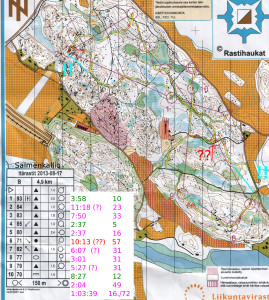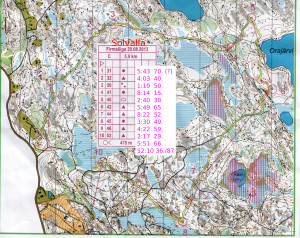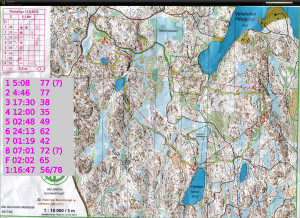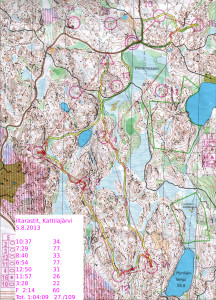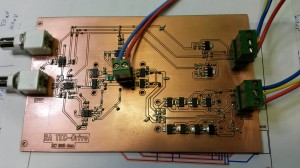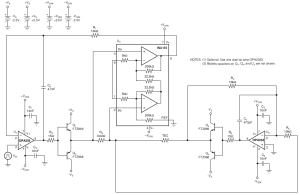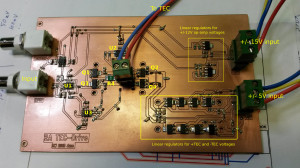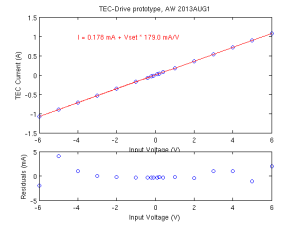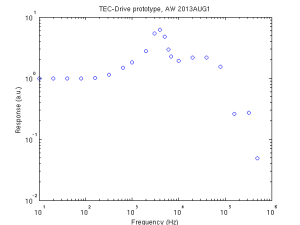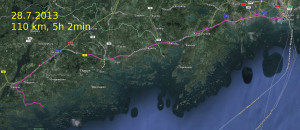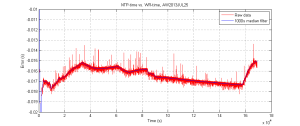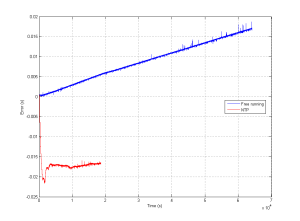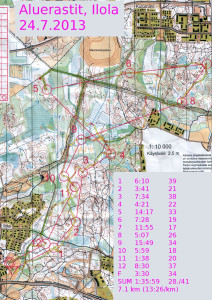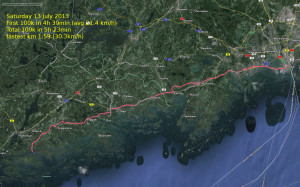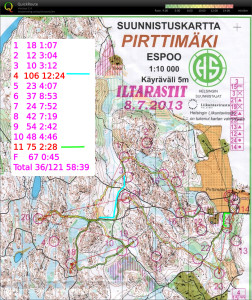- #2 could have taken a more direct route close to the control
- #6 ran very very close to the control - then decided to search right for 200m when the control would have been to the left about 5m.
- #7 should have clearly chosen either the path or the road - now an in-between choice that wasn't so great.
Firmaliiga 2013/5, Solvalla
Firmaliiga 2013/4, Kattilajärvi
First firmaliiga event this fall. Overall very physically demanding with most controls placed high up on hills/cliffs.
#1 a bit of circling before finding the right control
#2 ok and safe route, but slow
#3-#4-#5 OK
#6 very long leg with one or two big hills in the way. A route-choice with more running along the road might have been better.
#8 I tried to plan a good route to this control on the way to #6, but other runners and poor judgement caused extra minutes wasted here also.
Firmaliiga result 45./59
Iltarastit, Kattilajärvi
TEC-Drive prototype
I've been assembling and testing this PCB over the past few days:
It's a linear +/-2 A voltage-to-current amplifier meant for driving a constant current through a Thermoelectric Cooler (TEC). The circuit is (loosely) based on a 2001 Burr-Brown/TI application note "SBEA001 - Optoelectronics Circuit Collection".
Description: U1 drives one half of the H-bridge (Q1 and Q3) based on a feedback signal which is the amplified (U3) voltage drop across a current-sensing resistor (R4). The other H-bridge half (Q2 and Q4) is driven by an inverting amplifier (U2) which forces the other end of the TEC symmetrically, inverted, to follow the output from U1.
Here's how these things look on the PCB:
After some assembly, bugfixing, and tweaking I measured a DC transfer function like this:
I am happy with the small offset of <0.2 mA and the linearity seems good. There is a rather large gain-error since the design-goal was 200 mA/V and the measured sensitivity is 179 mA/V. The AC frequency response is quite ugly with a high peak at a few kHz. In the time-domain this shows up as severe ringing when driven by a square-wave input. (aside: the SBEA001 application note shows a SPICE-simulated frequency response up to MHz frequencies - theory/simulation and practice differ a lot in this case!).
Things learned so far:
- The original design used OPA353 op-amps. I had assumed these will work with bipolar +/-12 V supplies and the output swing would be close to +/-10 V. Not so! (the OPA353 is a single-supply op-amp). I used TL071 op-amps instead and they seem to work.
- Bypass capacitors close to the collectors of Q1-Q4 are essential (but not shown in the circuit-diagram!). The feedback loop would go mad with oscillations without 1 uF caps placed close to Q1-Q4.
- Q1-Q4 (and the linear regulators) will require heatsinking for >1 A currents.
- The current-sensing instrumentation amplifier U3 (I used an AD8221 instead of the INA155 in the application note) is probably the most sensitive part of this circuit. I added 200 Ohm series resistors on the inputs, as well as low-pass filter capacitors (100 nF) to ground on both + and - inputs. This seems to have a calming effect on noise/oscillation of the feedback loop.
- This kind of push-pull power stage shows significant cross-over distortion when the input signal crosses zero. Here the op-amp that drives the bases of the transistors needs to slew quickly either up or down in order to turn off one transistor and turn on the other one.
If all goes well this TEC-drive will be part of a temperature control system consisting of about five different PCBs or circuits:
- Digital controller. Talks over SPI to DAC and ADC cards. Runs PID and/or feed-forward algorithm on real-time OS to keep temperature steady.
- ADC-Card. Reads +/-10 V input voltage at 24-bit resolution and 1-100 samples/s speed.
- DAC-Card. Outputs +/-10 V voltages as input to TEC-drive. 1 sample/s speed is sufficient.
- Temperature-sensor frontend. Converts pt100 (or alternatively 10k NTC) resistance change into +/-10 V output for ADC. Previous blog posts here and here.
- TEC-Drive (this PCB). Converts +/-10 V input from DAC into a +/-2 A constant current through the TEC.
Sunday 110k
NTP time measurement
Here's a plot of the time error between the standard unix system-time, kept on time using NTP, and a much more accurate PTP-server based on White Rabbit that runs on a fancy FPGA-based network-card.
Note that without NTP a typical computer clock will be off by 10 ppm (parts-per-million) or more. This particular one measured about 40 ppm error in free-running mode (no NTP). That means during the duration of this 16e4 s measurement we'd be off by about 640 milliseconds (way off the chart) without NTP. With NTP the error seems to stay within 3 milliseconds or so. The offset of -16 milliseconds is not that accurately measured and could be caused by a number of things.
Aluerastit, Ilola
Saturday Night Bike Ride
Iltarastit, Pirttibacka
Problems on two out of the eleven controls yesterday. These also show up as the worst placings in the split times.
The #3-#4 (17-18 on the map) leg should have been a straightforward run along paths. However I took a short-cut from the path too soon and crossed about 1/3rd of the leg through the woods. Then right inside the control circle I ran past the control almost to the road south of it before returning. The blue line shows the path I should have taken.
On the very last control (14 on the map) it would have been clearly faster to return to the road (green line) and not go straighter through the light-green (thick) area.
